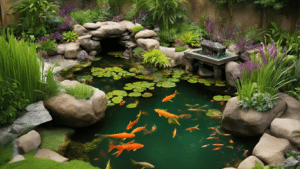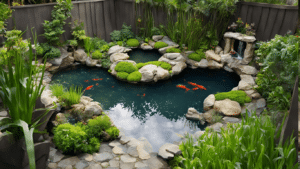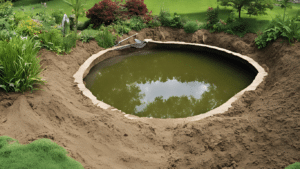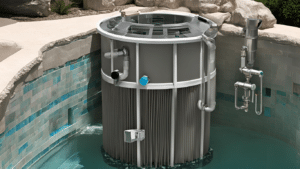A small garden pond is a fantastic way to enhance your backyard and create a calming, nature filled space. Whether your garden is big or small, a pond adds tranquility and charm with the sound of trickling water and vibrant plants. Plus, it’s easier to build than you think ! With a few simple steps, you can transform your outdoor area into a peaceful oasis. Ready to get started ? Let’s dive into creating your own beautiful backyard pond.
Why You Should Consider Adding a Small Garden Pond to Your Backyard

Adding a small garden pond to your backyard is more than just a way to spruce up your outdoor space it brings a whole new vibe to your home. Imagine relaxing by a tranquil pond surrounded by plants, where the sound of water creates a calming atmosphere. Not only does a garden pond add beauty, but it also attracts wildlife, like birds and frogs, turning your garden into a natural haven. Plus, it’s a low-maintenance way to create a backyard oasis without spending too much time or money. Ready to take your outdoor space to the next level?
Aesthetic Appeal and Relaxation with a Small Garden Pond
A small garden pond adds instant aesthetic appeal to any backyard, no matter the size. Whether it’s a modern design with sleek stones or a natural, rustic vibe with cascading water, a pond brings an element of tranquility to your garden. Imagine lounging on your patio and listening to the soft sound of water flowing while birds chirp nearby. The aesthetic and calming benefits of a pond will make your backyard the perfect retreat.
Attracting Wildlife and Boosting Biodiversity
One of the coolest perks of having a small garden pond is that it attracts wildlife, like fish, frogs, and even butterflies. These creatures not only add to the natural beauty of your garden but also help boost local biodiversity. Plus, ponds support a range of plants and aquatic life that thrive in a pond ecosystem. It’s the perfect way to bring nature to your backyard and support local wildlife while enhancing your garden’s beauty.
How to Choose the Best Location for Your Garden Pond

Choosing the right spot for your small garden pond is crucial for its long term success. You want a place that gets some sunlight about 4 6 hours a day because it helps plants thrive and keeps the water from getting too murky. However, avoid areas that are in full sun all day as this can cause algae growth. Look for a spot that’s not too close to overhanging trees, as fallen leaves can clog up the pond. A flat area is ideal, so your pond stays level, preventing water from spilling over unevenly. Keep these tips in mind, and you’ll be set for creating a peaceful water feature in your backyard !
Consider Sunlight Exposure for Pond Health
Sunlight plays a key role in the health of your garden pond, as it affects water temperature and plant growth. Make sure to choose a spot that offers a balance between sunlight and shade. A few hours of direct sunlight are perfect to help your pond plants flourish, but too much sun can encourage algae. Find that sweet spot with partial shade to keep the pond cool and balanced throughout the day.
Avoiding Tree Roots and Debris Near Your Pond
When selecting the best location for your garden pond, consider the proximity to large trees or plants with deep roots. Roots can invade the pond area, disrupting the water balance and potentially damaging your pond liner. Plus, trees dropping leaves into the pond can increase maintenance and cause water quality issues. Look for a space that’s clear of trees or other large plants to keep your pond clean and low-maintenance.
Step by Step Guide to Building Your Small Garden Pond

Building your own small garden pond can be a fun and rewarding project. With the right tools and a bit of planning, you can create a peaceful retreat right in your backyard. Start by choosing the right spot for your pond (as we discussed earlier), and gather all the materials you’ll need, like a pond liner, stones, and plants. From there, it’s all about digging your pond to the desired shape, lining it properly to prevent leaks, and filling it with water. Don’t forget to install a pump for water circulation and filtration to keep things fresh! After all that, add plants and maybe some fish to complete your tranquil backyard paradise. It’s easier than it sounds, and the results are totally worth it!
Choosing the Right Materials for Your Pond
When building your small garden pond, choosing the right materials is crucial for its longevity. Make sure to use a high quality pond liner that’s durable and flexible enough to shape your pond the way you want. You’ll also need rocks, gravel, and plants that will not only make the pond look amazing but also help with water filtration. Consider low-maintenance options like native pond plants to keep your pond eco friendly and sustainable.
Maintaining Your Garden Pond for Long Term Success
After setting up your pond, maintenance is key to ensuring it stays healthy and beautiful for years to come. Regularly check the water levels and clean out any debris to avoid clogging the filter. Consider adding a pond pump to help keep the water moving, which prevents stagnation and algae growth. By staying on top of these tasks, your small garden pond will continue to be the centerpiece of your backyard!
Choosing the Right Pond Liner and Filtration System

When it comes to creating a small garden pond, choosing the right pond liner and filtration system is crucial for long term success. The pond liner is your pond’s foundation, ensuring water stays where it should and doesn’t seep into the ground. Go for a durable, UV resistant liner made from materials like EPDM rubber, which will last for years without deteriorating. Pair this with a quality filtration system that keeps the water clear and healthy. A good filtration system prevents algae build-up and helps maintain a clean environment for fish and plants. It’s all about finding that balance between functionality and aesthetics, so your pond thrives season after season.
Selecting the Best Pond Liner Material
The type of liner you choose affects both the longevity of your pond and its overall appearance. EPDM rubber is highly recommended because it’s flexible and resistant to UV rays, ensuring your pond liner lasts through all weather conditions. Alternatively, flexible PVC liners are more affordable but may not have the same durability. When selecting your liner, consider your pond’s shape and size to ensure a snug fit.
Choosing the Right Filtration System for Your Pond
A proper filtration system is key to maintaining a healthy pond. Mechanical filters help remove debris and particles from the water, while biological filters break down harmful substances. Depending on your pond’s size, choose a system that can handle the water volume efficiently. Keep in mind that the best filtration systems also promote water circulation, keeping your pond’s ecosystem balanced and clear for fish and plants.
Adding Fish and Plants to Your Small Garden Pond

One of the best ways to enhance your small garden pond is by adding fish and plants. These not only bring life to your pond but also help balance the ecosystem. When selecting fish, go for species that thrive in small ponds like goldfish or koi. These fish are not only colorful but also add movement and energy to the pond. For plants, floating plants like water lilies or submerged ones like anacharis can improve water quality by absorbing excess nutrients and providing shade for the fish. Keep in mind that the right balance of plants and fish ensures your pond remains healthy and visually appealing all year round.
Choosing the Best Fish for Your Pond
When picking fish for your garden pond, consider the size of your pond and the local climate. Goldfish and koi are popular choices as they’re hardy and easy to care for. However, if your pond is on the smaller side, you might want to stick with goldfish, as koi need more space to thrive. Make sure to monitor the pond’s temperature and water quality to keep your fish healthy. Don’t forget to add a few fish-friendly plants that can provide them with shelter and a natural food source!
Best Pond Plants for Aesthetic and Health Benefits
Pond plants are essential for a healthy ecosystem. Floating plants like water lilies not only look gorgeous but also help cool the water and reduce algae growth. Submerged plants like hornwort provide oxygen to the water, while marginal plants like cattails add a touch of beauty. These plants contribute to better water quality, keeping it clean and oxygenated for your fish.
Conclusion
Creating a small garden pond in your backyard isn’t just a fun project it’s a gateway to bringing a slice of nature closer to home. From choosing the perfect location to adding the right fish and plants, each step transforms your outdoor space into a serene retreat. We hope this guide has inspired you to start your own garden pond journey. Remember, maintaining a balanced ecosystem is key to keeping your pond thriving.
FAQ
1. What are the benefits of having a small garden pond?
A small garden pond can add beauty and tranquility to your backyard, attract wildlife like birds and butterflies, and create a relaxing space to unwind. Plus, it enhances your garden’s overall aesthetics and promotes biodiversity.
2. How much space do I need to build a garden pond?
You don’t need a large yard! Even a compact space can accommodate a small garden pond. The key is to choose a location that gets partial sunlight and complements your existing garden layout.
3. What is the best material for a garden pond liner?
Flexible rubber liners, such as EPDM or PVC, are highly recommended for their durability and flexibility. They can conform to various shapes and sizes, ensuring your pond remains leak-free.
4. Can I add fish to my small garden pond?
Absolutely! Fish like goldfish or koi are popular choices for small garden ponds. Just make sure the pond has proper filtration, adequate depth, and a balanced ecosystem to keep them healthy.
5. What types of plants should I add to my garden pond?
Water lilies, lotus, and floating plants like duckweed or water hyacinths are great options. They provide shade, oxygenate the water, and maintain ecological balance in your pond.